

Gain Advantage through Analytics. Consumer Behavior: Factors Affecting Member Attrition and Retention. The Value Chain of Analytics. Data vs.
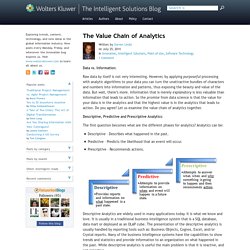
Information: Raw data by itself is not very interesting. However, by applying purposeful processing with analytic algorithms to your data you can turn the unattractive bundles of characters and numbers into information and patterns, thus exposing the beauty and value of the data. But wait, there’s more. Information that is merely explanatory is less valuable than information that leads to action. Descriptive, Predictive and Prescriptive Analytics: The first question becomes what are the different phases for analytics? Descriptive – Describes what happened in the past.Predictive – Predicts the likelihood that an event will occur.Prescriptive – Recommends actions.
Descriptive Analytics are widely used in many applications today. The next step up from descriptive analytics is predictive analytics. The next level up is prescriptive analytics. Conclusion: While descriptive and predictive analytics have maturated in many organizations, prescriptive analytics are still being pursued. Prescriptive Analytics. Put simply, descriptive analytics describes the past and predictive analytics provides a probability of what might happen.
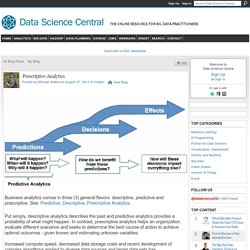
In contrast, prescriptive analytics helps an organization evaluate different scenarios and seeks to determine the best course of action to achieve optimal outcomes - given known and estimating unknown variables. Increased compute speed, decreased data storage costs and recent development of complex algorithms applied to diverse data sources and larger data sets has made prescriptive analysis feasible and affordable for most organizations. Scientific techniques include data science (e.g., machine learning, algorithms, artificial intelligence, bayesian probability, monte carlo simulations...etc.), game theory, optimization, simulations, and decision-analysis methods.
Prescriptive analytics goes beyond predicting future outcomes by also suggesting actions to benefit from the predictions and showing the decision maker the implications of each decision option. Document. Steve%20Pettit%20Keynote.pdf. A Statistician's 'Big Tent' View on Big Data and Data Science (Versio… Big Data & Hadoop. Best-practices-for-implementing-apache-hadoop-paper.pdf.
Hadoop-analytics-on-vblock-with-isilon.pdf. Hadoop-analytics-on-vblock-with-isilon.pdf. Hadoop. SPR9_35_IBM_Hattori Ryuichiro. Want a Big ROI for Big Data? Use Hadoop to Drive Real-Time Automation. Looking Ahead at the 2015 Business Intelligence Landscape Organizations that reap high return rates on Big Data projects do so by changing operational systems for everybody, rather than “enlightening a few with pretty historical graphs,” according to IT research and consulting firm Wikibon.

How do you do that? You stop using Big Data to drive “using the rear-view mirror.” Instead, you couple Big Data insights with in-memory technologies so you’re “driving with real-time input through the front windshield,” writes David Floyer, a former IDC analyst and co-founder and CTO of Wikibon.org. Floyer’s lengthy piece on Big Data ROI goes into the technical details on how you piece this together. RobPeglar_Introduction_to_Analytics_and_Big_Data_Hadoop. Url?sa=t&rct=j&q=&esrc=s&source=web&cd=139&cad=rja&uact=8&ved=0CEQQFjAIOIIBahUKEwi-oMvbwLLHAhVQWo4KHeVWCiM&url= 9Hechler_Big Data and Hadoop - Mainframe Aktuell - FINAL. Best-practices-for-implementing-apache-hadoop-paper.pdf. Accenture-Hadoop-Deployment-Comparison-Study.pdf. SAS Analytic Solutions Running on a Hadoop Cluster using YARN Presentation 1.
AST-0112051_UnlockingPromise. Big-data-intelligence-in-logistics-based-onhadoop-and-map-reduce.pdf. 269.pdf. How Hadoop Involves Supply Chain Management. The term Hadoop has been mentioned everywhere of late.
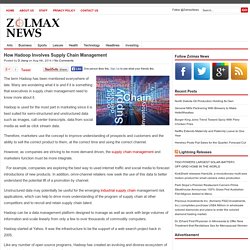
Many are wondering what it is and if it is something that executives in supply chain management need to know more about it. Hadoop is used for the most part in marketing since it is best suited for semi-structured and unstructured data such as images, call center transcripts, data from social media as well as click stream data. Therefore, marketers use the concept to improve understanding of prospects and customers and the ability to sell the correct product to them, at the correct time and using the correct channel. However, as companies are striving to be more demand driven, the supply chain management and marketers function must be more integrate. For example, companies are exploring the best way to used internet traffic and social media to forecast introductions of new products. Hadoop started at Yahoo. A few of those include Pig, YARN, Hive, Avro and Zookeeper. 269.pdf.
5.pdf. Three things you should know about big data and analytics – Technology – CSCMP's Supply Chain Quarterly. Technology The terms "big data" and "analytics" are widely used but often are not clearly defined.

The explanations presented here will help managers understand what these concepts really mean and how they can use them to improve their supply chains. Wherever you look lately, the concepts of analytics and "big data" are being hyped by the media, consultants, and software vendors. Some of that hype is justified, as some companies are indeed using analytics and big data to transform their businesses. But most supply chain managers aren't getting a clear definition of what "analytics" and "big data" really mean.
Without a full understanding of what the field of analytics is about, supply chain managers may be missing out on many opportunities—both for their companies and for themselves. RobPeglar_Introduction_Analytics _Big Data_Hadoop. Hadoop - Big Data Overview. Due to the advent of new technologies, devices, and communication means like social networking sites, the amount of data produced by mankind is growing rapidly every year.

The amount of data produced by us from the beginning of time till 2003 was 5 billion gigabytes. If you pile up the data in the form of disks it may fill an entire football field. The same amount was created in every two days in 2011, and in every ten minutes in 2013. This rate is still growing enormously. Though all this information produced is meaningful and can be useful when processed, it is being neglected. 90% of the world’s data was generated in the last few years. Hadoop's Second Generation Offers More To Enterprises. The first Hadoop tools weren't easy to deploy or manage.
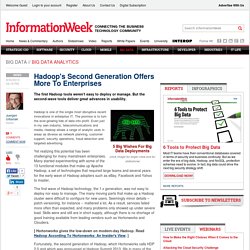
But the second-wave tools deliver great advances in usability. How To Explain Hadoop To Non-Geeks. With Hadoop 2.0's arrival, you will need to explain the benefits of the reigning big data platform to business types and C-suite executives.
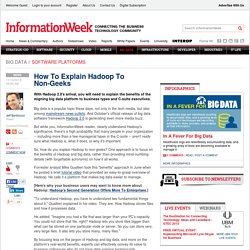
Big data is a popular topic these days, not only in the tech media, but also among mainstream news outlets. And October's official release of big data software framework Hadoop 2.0 is generating even more media buzz. But while you, InformationWeek reader, clearly understand Hadoop's significance, there's a high probability that many people in your organization -- including more than a few managerial types in the C-suite -- aren't really sure what Hadoop is, what it does, or why it's important. So, how do you explain Hadoop to non-geeks? RobPeglar_Introduction_Analytics _Big Data_Hadoop. What is Hadoop? What is NoSQL? What is MapReduce? The flow rate of data in this modern age – think of the Hoover Dam flooding the Colorado river As the world becomes more information-driven than ever before, a major challenge has become how to deal with the explosion of data.

Traditional frameworks of data management now buckle under the gargantuan volume of today's datasets. Fortunately, a rapidly changing landscape of new technologies is redefining how we work with data at super-massive scale. These technologies demand a new breed of DBAs and infrastructure engineers/developers to manage far more sophisticated systems. Here is an overview of important technologies to know about for context around big data infrastructure.
Traditional RDBMS (older technology, losing relevance) NoSQL Database Systems Hadoop, MapReduce, and massively parallel computing Traditional RDBMS (relational database management system) have been the de facto standard for database management throughout the age of the internet. Telematics and Big Data: Next Generation Automotive Technology. Telematics and Big Data: Next Generation Automotive Technology. Wp_56343.pdf. Wp_56343.pdf. s13677-015-0026-8.pdf. Movement Analytics in Connected Cities will Unlock Big Data Revenue Opportunities for Mobile Operators. Monday, February 16, 2015.
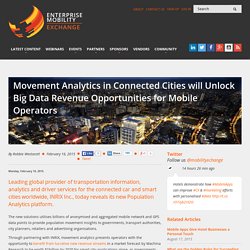
Leading global provider of transportation information, analytics and driver services for the connected car and smart cities worldwide, INRIX Inc., today reveals its new Population Analytics platform. The new solutions utilises billions of anonymised and aggregated mobile network and GPS data points to provide population movement insights to governments, transport authorities, city planners, retailers and advertising organisations. Through partnering with INRIX, movement analytics presents operators with the opportunity to benefit from lucrative new revenue streams in a market forecast by Machina Research to be worth $1billion by 2020 for smart city applications alone, as governments invest significantly to attempt to reduce the impact of traffic congestion, upgrade transport infrastructure and improve urban mobility as more and more people move into our largest population centres.
Telefonica_research_paper. C2S_OP_No10_WP5_Sustainable_Data_Science_for_Sustainable_Cities.pdf. Big%20Data%20Analytics.pdf. P83. Mr_Danny_Woolard_Presentation. 2014-Probe-Data-Fiona. Titled. IQPC%20conf%202015_0.pdf. IQPC%20conf%202015_0.pdf. 20Working%20Paper_Big%20Data%20for%20Development%20in%20China_Nov%202014.pdf. Untitled. BigDataTransport.pdf. UNDP%20Working%20Paper_Big%20Data%20for%20Development%20in%20China_Nov%202014.pdf. Putting Telematics' Big Data to Work - FleetLocate. It’s not enough for fleet companies to gather critical business data; they have to put it to work (or else it’s just a big pile of numbers). Sounds easy enough, right? Wrong. There remain a substantial number of small to mid-sized fleets that haven’t been able to put all that information to use, or who’ve simply do not have the tools to make it actionable.
They’re missing opportunities to reduce expenses, increase productivity and improve customer service. Frankly, it’s time for them to get with it. The growth of big data is terrific news for companies who are looking for ways to improve business operations, enhance customer relations, and increase revenue. The more actionable data businesses gather, the better opportunities they’ll have to use it to their advantage. With a clear plan and a supportive effort, big data can be a great way for fleets to get ahead. Learn more about Spireon’s telematics solutions designed for fleet management and trailer management, visit FleetLocate.com.
Use-Case_Big-Data-Fleet-Management. 3 challenges fleet managers wanting to use Big Data will face. Apr 30 Big data is set to transform the world of (fleet) management as we know it. The increasing vehicle connectivity and the Internet of Things will make data big, in the sense of it becoming an essential part of fleet strategy. Those companies that are able to derive the right insights from such a vast amount and variety of data will be able to create new and significant value for their own, and their customers’ businesses. However with the production of such massive data sets comes the obvious challenge of how to turn such complexity into valuable insights for one’s organisation. Big-data-get-started-reference-guide. 1866E0615025.pdf. Big-Data Processing Techniques and Their Challenges in Transport Domain (PDF Download Available) Big data: What’s your plan? The payoff from joining the big-data and advanced-analytics management revolution is no longer in doubt.
The tally of successful case studies continues to build, reinforcing broader research suggesting that when companies inject data and analytics deep into their operations, they can deliver productivity and profit gains that are 5 to 6 percent higher than those of the competition. The promised land of new data-driven businesses, greater transparency into how operations actually work, better predictions, and faster testing is alluring indeed. But that doesn’t make it any easier to get from here to there. The required investment, measured both in money and management commitment, can be large.